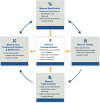Why do we need quality measures in emergency medicine?
- PMID: 39697807
- PMCID: PMC11652395
- DOI: 10.1002/emp2.13329
Why do we need quality measures in emergency medicine?
Abstract
Quality measures increasingly influence the delivery and reimbursement of care provided in emergency departments. While emergency physicians are accustomed to using quality measures to improve care delivery, payors, including the Centers for Medicare and Medicaid Services (CMS), are increasingly adjusting reimbursement to measure performance as a means to bend the cost curve and improve the value of healthcare services. The American College of Emergency Physicians Quality and Patient Safety Committee presents this whitepaper to guide practicing emergency physicians through the policy context of implementing measures in emergency care and understanding its impact reimbursement. This paper summarizes current CMS programs such as the merit-based incentive payment system (MIPS), MIPS value pathways, and alternative payment models and various reporting mechanisms. It is crucial for emergency physicians to understand the quality measure development process, the need for more emergency medicine-specific quality measures, and the growing significance of measure performance in the payment of emergency care.
Keywords: CMS; emergency medicine; payment reform; quality measures; reimbursement; value‐based care.
© 2024 The Author(s). Journal of the American College of Emergency Physicians Open published by Wiley Periodicals LLC on behalf of American College of Emergency Physicians.
Conflict of interest statement
The authors declare no conflicts of interest in accordance with ICJME guidelines.
Figures



References
-
- AHRQ . Six Domains of Health Care Quality. AHRQ. Accessed December 30, 2023. https://www.ahrq.gov/talkingquality/measures/six‐domains.html
Grants and funding
LinkOut - more resources
Full Text Sources

